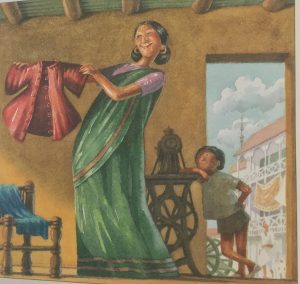Source
University of Florida’s Baldwin Library of Historical Children’s Literature
Baldwin Call #
#23h20890
Description
In the preface of this adaptation, creator Fred Marcellino boldly asserts that Bannerman’s original text “is a story that clearly takes place in India.” Operating on this premise, Marcellino attempts to return to Bannerman’s supposed original setting by recasting Sambo and his family as Indian. The father and other adult men, for instance, wear a pagri, or turban, while the mother wears a sari. Additionally, this version changes the family’s controversial names to monikers that, Marcellino claims, are “authentic Indian names.” Little Black Sambo becomes Little Babaji, Black Mumbo becomes Mamaji, and Black Jumbo becomes Papaji.
On the surface, Little Babaji seems like a well-intentioned effort to rehabilitate Sambo in the spirit of the original text. However, a close examination of the picture book reveals three significant problems with Marcellino’s attempt to Indian-ize Little Black Sambo.
First, neither Bannerman nor her original narrative explicitly identify the setting as India. Though Bannerman does use the Indian word “ghi,” she represents her characters as ethnically ambiguous, suggesting that the narrative actually takes place in, as Dinnage terms it, an imaginary “never-never land” populated by “never-never people.” Thus, Marcellino’s attempt to explicitly race Sambo as Indian and to restore him to his alleged, but unconfirmed, Indian heritage seems dubious at best.
Second, two of Marcellino’s new names are not, in fact, “authentic Indian names.” In her review of Little Babaji, Barbara Bader notes that “ji is inappropriate for a child, and Baba is neither a first name nor anything else that quite fits.” Additionally, in India the term “Mamaji” refers to a maternal uncle, not to a mother figure. Consequently, it seems that the white Marcellino is more concerned with giving his characters names that sound Indian based on Anglo-centric stereotypes than with using truly authentic names from Indian culture.
Finally, Marcellino’s illustrations threaten to stereotype and Orientalize the characters. For example, Marcellino depicts Papaji and other men adorned with turbans. While this imagery may have some cultural authenticity, when deployed by a white, Western illustrator, the turban remains an easy icon of Indian “Otherness” that can be easily deployed in order to “authenticize” Marcellino’s version. Thus, despite its good intentions, The Story of Little Babaji unfortunately reinforces racist stereotypes that collapse all Indian people into the exotic and Oriental Other.
For more thorough analyses of Marcellino’s picture book, see:
Bader, Barbara. “Sambo, Babaji, and Sam.” The Horn Book Magazine, no. 5, 1996, p. 536.
Sircar, Sanjay. “The International Case of Little Colourless Babaji, Reracinating, Returning, and Retaining a Classic.” Signal: Approaches to Children’s Books, vol. 90, 1999, pp. 187-211.
Creator
Helen Bannerman
Contributor(s)
Illustrated by Fred Marcellino
Publisher
Harper Collins
Publication Date
1996
Format
72 pages; colored illustrations; 6.5 x 0.2 x 6.5 inches
Language
English



